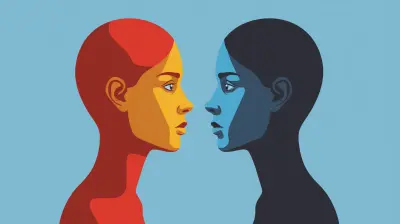The Role of CBT in Addiction Recovery: Breaking Free from Old Habits
25 July 2025
Struggling with addiction often feels like being trapped in a never-ending loop. You tell yourself this is the last time, swear you'll quit tomorrow, and then... you’re back at square one. Sound familiar?
Trust me, you're not alone.
What if I told you there’s a proven method that can help you break that cycle — not just temporarily, but for good?
Let’s talk about Cognitive Behavioral Therapy (CBT) and how it’s become a game-changer in addiction recovery. It's not magic, but it sure feels close to it when you start to experience its impact.
What Is CBT, Really?
Let’s start with the basics.CBT — short for Cognitive Behavioral Therapy — is a type of psychotherapy that’s all about the relationship between your thoughts, feelings, and behaviors.
Sounds simple, right? But here’s the thing: CBT isn’t about digging through your past looking for villains. It’s about helping you understand how your current thinking patterns affect your actions — especially actions that aren’t doing you any favors, like using drugs or alcohol.
CBT is basically like rewiring your brain. Think of it as switching out the playlist in your head from one that glorifies bad habits to one that champions healthy living.
Addiction: When Habit Becomes a Trap
Addiction isn’t just about poor choices or lack of willpower. It’s way deeper than that.When you’re stuck in addiction, your brain creates mental shortcuts — triggers — that scream, “The only way to feel better is to use.” Over time, these shortcuts become so automatic, you don’t even realize they're happening.
Let’s say stress hits. Your brain says: relief = another drink. That thought → leads to craving → leads to relapse.
Now enter CBT.
How CBT Helps Break Those Old Habits
So, how does CBT untangle this mess?Here’s the magic sauce: CBT helps you identify those negative thought patterns and replace them with healthier ones. It teaches your brain a new formula:
Trigger → Different Thought → Healthier Response.
Let’s walk through a real example.
🧠 Old Pattern:
- Situation: Argument with a loved one.- Thought: “I suck. I can’t deal with this.”
- Behavior: Pour a drink to numb the emotions.
🌱 New CBT-Based Pattern:
- Situation: Same argument.- Thought: “This sucks, but using won’t make it better.”
- Behavior: Take a walk, breathe, call a friend.
See the shift? You’re not just white-knuckling your way through cravings. You’re changing how you think, which changes how you act.
The 5 Core Principles of CBT in Addiction Recovery
Let’s break this down into digestible chunks:1. Identifying Triggers
CBT helps you get laser-sharp clarity on what lights the fuse of your addiction — whether it’s stress, loneliness, certain people, or even specific places.2. Challenging Distorted Beliefs
Your internal dialogue matters more than you think. Phrases like “I’ll never change” or “I’m too far gone” get exposed for what they are: lies.CBT helps you stop believing everything you think.
3. Developing Coping Strategies
Instead of defaulting to substance use, CBT teaches you practical tools to manage stress, anxiety, and cravings. Think journaling, breathing techniques, or even simple distractions like a walk or music.4. Behavioral Modification
You’ll learn how to replace unhealthy behaviors with positive ones. It’s not about just cutting out the bad — it’s about filling that space with something better.5. Preventing Relapse
CBT arms you with a relapse prevention plan. When things get tough (and they will), you’ll have a mental playbook ready to go.Real Talk: Does CBT Actually Work?
Let’s get brutally honest. Some people hear “therapy” and immediately picture lying on a couch talking about their mother. That’s not CBT.CBT is active, practical, and results-driven.
In fact, studies consistently show that CBT significantly reduces the chances of relapse. It’s been shown to be especially effective for addictions involving alcohol, drugs, gambling, and even food.
And it doesn’t just work in isolation. Pairing CBT with other treatments — such as support groups, medication, or lifestyle changes — creates a rock-solid recovery foundation.
CBT in Action: What to Expect in Therapy
You might be wondering, “Okay, but what does a CBT session actually look like?”Here’s a peek behind the curtain.
Step One: Setting Goals
Your therapist will work with you to define what you’re aiming for. Not just “stop using,” but deeper goals — like repairing relationships or reducing anxiety.Step Two: Thought Tracking
You’ll learn to catch those automatic thoughts that fuel addictive behaviors. Think of this as turning on the lights in a dark room.Step Three: Reframing Thoughts
You’ll practice challenging and replacing negative thoughts. It can feel awkward at first, but give it time — it works.Step Four: Homework Assignments
Yep, there’s homework. But instead of solving math problems, you’re solving you problems. Journals, activity logs, or even mini-behavior experiments.Over time, those small shifts add up to massive transformations.
Why CBT Feels Empowering
There’s something incredibly powerful about realizing you have control over your own mind.Most people stuck in addiction feel powerless. CBT flips that script. It hands you the pen and says, “You write your story now.”
You’re not broken. You’re just stuck in a mental pattern that no longer serves you. That’s fixable.
Is CBT Right for You?
Let’s be real — CBT isn’t a one-size-fits-all solution. But it is widely adaptable.Whether you’re dealing with substance use, behavioral addictions (like gambling or shopping), or co-occurring issues like anxiety or depression, CBT can help.
It’s also flexible: CBT can happen one-on-one, in a group, or even through online programs and apps. The key is consistency and honesty.
Tips for Getting the Most Out of CBT
Ready to dive into CBT? Here are a few pointers to make your journey more effective:✅ Be Open
Your therapist isn’t there to judge. The more honest you are, the more helpful the sessions will be.✅ Practice Outside Sessions
CBT isn’t just about what happens in the therapy room. The real change happens when you apply the tools in daily life.✅ Track Your Progress
Write things down. Reflect. Celebrate even the tiniest victories — they add up.✅ Stay Patient
Change takes time. You’re undoing years, maybe decades of mental habits. Give yourself grace.The Long Game: Recovery Is a Journey
Recovery isn’t a straight line. You’ll have good days, bad days, and days where you feel like giving up.CBT gives you the roadmap to navigate all of it.
Remember, addiction isn’t your identity. It’s just a challenge you’re facing right now. CBT helps you separate who you really are from the habits you’re trying to break.
This is your time to rewrite the narrative.
Bottom Line: CBT Works When You Work It
If you’re tired of feeling stuck... If you’re ready to stop surviving and start thriving... CBT could be the key you’ve been searching for.It's not a miracle cure. But with commitment, courage, and a little help along the way, it might just be your secret weapon to lasting recovery.
The old habits? They don’t stand a chance.
all images in this post were generated using AI tools
Category:
Cognitive Behavioral TherapyAuthor:

Matilda Whitley
Discussion
rate this article
1 comments
Callisto Riggs
How does CBT reshape addictive thinking?
August 8, 2025 at 3:11 PM

Matilda Whitley
CBT reshapes addictive thinking by challenging and changing negative thought patterns, helping individuals recognize triggers, and promoting healthier coping strategies, ultimately fostering a more positive mindset towards recovery.


